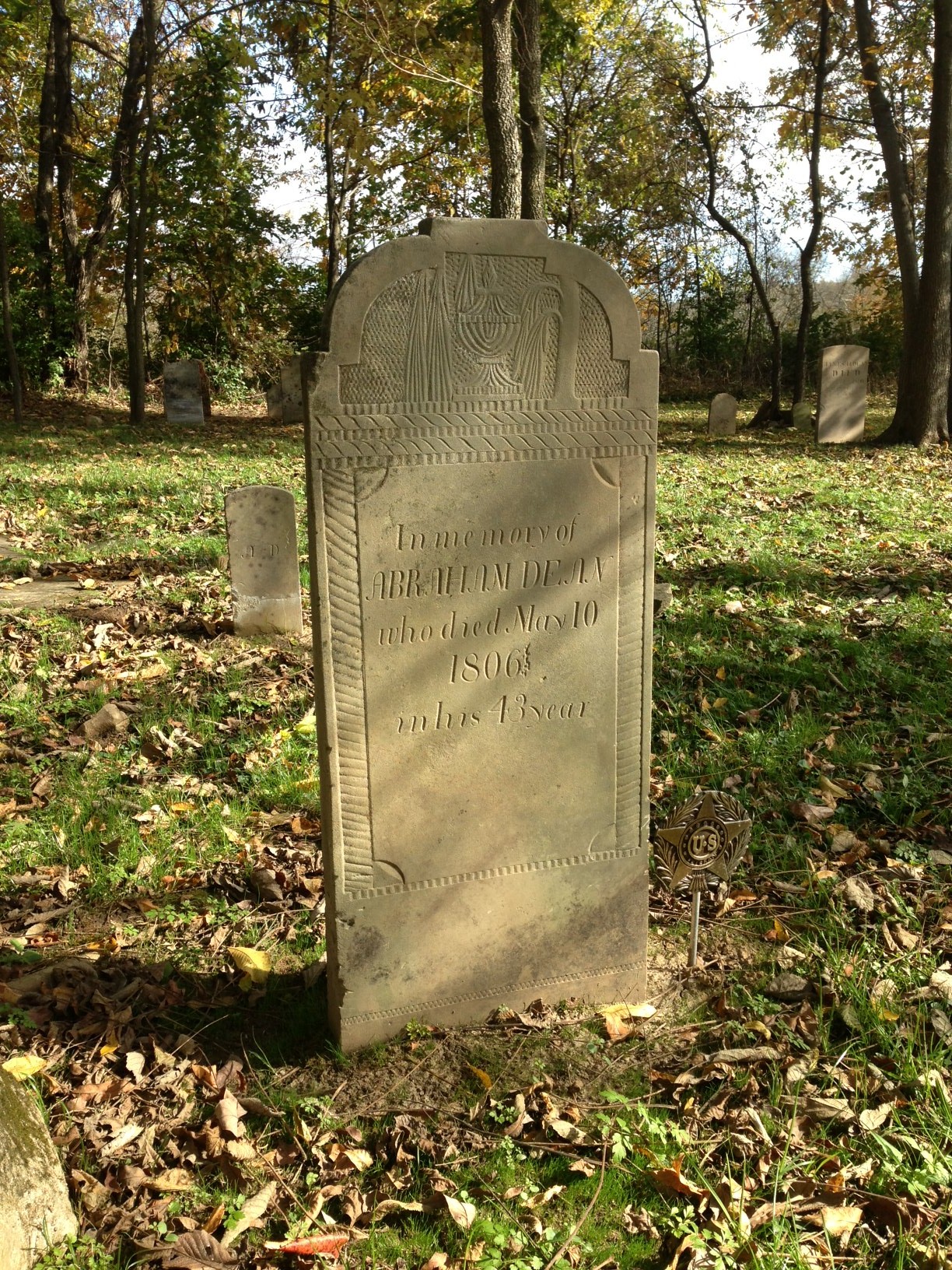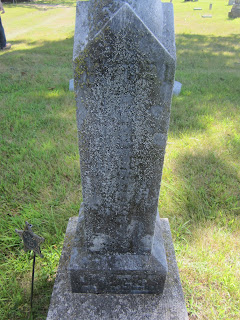I've been going back through the
WikiTree pages and filling in the siblings and their first-generation children for every one of my direct ancestors. I've finished the Deans (that is, the straight patronymic line, not including all of the wives who married in), so this seems a good time to summarize the Deans in America.*
The Deans were Scotch-Irish, an ethnic/religious group mostly from northern England and southern Scotland. They were Protestant dissenters, strong Calvinists, who were first settled in Ulster in the 1500s (because they were causing too much trouble as border raiders in England), and later encouraged or forced to migrate to the American colonies, particularly in the 1700s. Over 300,000 Scotch-Irish migrated from Ulster to the Americas between 1710 and 1810, mostly to Pennsylvania, which had the most welcoming religious laws, or south along the Appalachian mountains, particularly into the Carolinas.
James Dean (about 1740-?) and
Catherine Gamble (about 1740-?): These were the first Deans in the Americas. They were both born in Ireland, almost certainly in Ulster, and settled in Pennsylvania. They were married after their arrival in the Americas, which suggests that Catherine's parents and siblings could also be somewhere in Pennsylvania, although I haven't found them. They arrived sometime before 1760, since that was the year their first child, Margary, was born. In
History of Huntingdon and Blair Counties, Pennsylvania, by J. Simpson Africa (p. 329), James is listed under the pioneers of Oneida Township, with his son, Abraham. This is an area of central Pennsylvania that was badly hit during the Seven Years War (aka French and Indian War). In the generation before, it had been largely cleared of people, Native and European alike. When the war ended, the Scotch-Irish were particularly prevalent among the new settlers. The same source says James was a member of the first board of elders elected by the congregation of
Hart's Log Church, Sept. 10, 1787. He and Catherine may very well have settled elsewhere in Pennsylvania earlier, but there is no record of them before their arrival in Oneida Township. His farm was located near what is today Alexandria, Pennsylvania.
 |
| Old Hartslog Church |
We only have records of two children, Margary and Abraham (see below). Margary married Colonel John Canan, who was also Scotch-Irish, and stayed near her parents in Pennsylvania. I blogged about
the Canan family previously. John Canan was a Revolutionary War soldier and served in the General Assembly and as state senator for Pennsylvania. He developed coal and iron deposits, building one of the first furnaces in the region. Small families were very rare at this time, although childhood mortality was high. It is possible/likely that there were other children born to James and Catherine, but we have no record of them.
 |
Tombstone of Abraham Dean, Ross County, Ohio
photograph by Scott
http://www.findagrave.com/cgi-bin/fg.cgi?page=mr&MRid=47082416 |
Abraham Dean (1763-1806) and
Sarah Stewart (1766-1837): Abraham and Sarah were both born in Pennsylvania to Scotch-Irish families. He served as a private 3rd class in the 7th company, 1st battalion, of the Cumberland County Militia during the Revolutionary War (1). In 1784 he bought land north of present-day Alexandria, Pennsylvania, and named the tract "Mexico" (2). He and Sarah were married sometime around 1790. By 1811, however, they had moved their family to South Salem, in Ross County, Ohio. Ohio had been Shawnee and Lenape land (along with other tribes), and under military occupation by the French until the Revolutionary War. Freed from restraint by the British government, the new United States started pushing westward soon after independence. The first major Euro-American colony in Ohio was at Marietta in 1788, with statehood following in 1803 (after decades of war to enforce Euro-American rule). The Deans entered an Ohio that was only recently conquered and sparsely inhabited by Euro-Americans.
At least one of Sarah Stewart's sisters, Margaret Stewart Brown, and her family, also moved to South Salem. More of her siblings may have joined them. As I mentioned in a
previous post, this type of clan migration was common. Abraham and Sarah had eight children who scattered throughout the Midwest. Their fifth child (and second son) was John Stewart Dean.
John Stewart Dean (1792-1872) and
Hannah Baird (1800-1828): John was born in Lancaster County, Pennsylvania. He was a child when his family moved to Ohio. Hannah was probably born in Lincoln County, North Carolina, near King's Mountain, where her father fought during the Revolutionary War (3). In fact, he was one of the original signers of the
Tryon Resolves, an early declaration of resistance to British rule. The Bairds were another Scotch-Irish family that had originally been from Pennsylvania. The Bairds moved into Ohio in the early 1800s, partly because of their opposition to slavery, Many Bairds were participants in abolitionist activities.
Hannah and John were married in Brown County, Ohio, in 1819. Hannah's older brother,
John Hill Baird, was a good friend of John Stewart Dean. They served together during the war of 1812 (3). After returning to their homes (they had to walk across Ohio after being discharged), John Hill Baird married the eldest Dean sister,
Catharine, and John Stewart Dean married his friend's sister, Hannah. Hannah and John had three children, the oldest of whom was Abram Stewart Dean. Unfortunately, Hannah died quite young and was buried in the Dean cemetery in South Salem, Ohio. John went on to marry twice more.
In 1847, John led a group of five families (mostly his relatives) from South Salem to Polk County, Iowa(4). They were among the first families to settle in the area. The U.S. Army had built a fort on the Des Moines River in 1843. (Fun fact, the fort was originally going to be called Fort Raccoon, after the other river that joins the Des Moines at that point. Only by the grace of the War Department was Iowa saved from having Raccoon as its state capital.) The fort was there to control the Sauk and Meskwaki tribes, who had been forcibly resettled there from eastern Iowa. It wasn't long, however, before the army moved the tribes farther west, and in 1846 the fort was abandoned as Native people were denied land rights in Iowa. The city was opened to settlement as the seat of Polk County in May of 1846, and the Deans arrived in November of 1847.
 |
Walnut Street Bridge, Des Moines, Iowa, 1866
On the far side of the bridge was the site of the original
Dean household in Iowa. |
The John Stewart Dean became a leading man in Des Moines (4). He was known as "Uncle Johnny" throughout the area. He and his family settled on the east side of the river, and were founders of the Presbyterian church, which met for the first time in his home. He was instrumental in getting the state capital located in east Des Moines, donating some of his land to the project. To this day, the state capital sits at the end of Dean Street, just to the west of Dean Lake. The Dean's original homestead was in downtown Des Moines, along the river. In 1851 a massive flood destroyed much of the area. The Deans resettled a few miles east, closer to where John's son, Abram, had placed his farm.
Abram Stuart Dean (1820-1859) and
Anne Retta Welsheimer (1819-1905): Abram was born in Ohio, where he met and married Anne Welsheimer. Anne was a first in the direct Dean line: a wife who was not primarily of Scotch-Irish stock. In fact, her mother was probably Scotch-Irish (there's very little known about her), but her father was German (5). The Welsheimers had settled in Pennsylvania in the 1760's. They came from Berlin, probably for religious reasons (they were Calvinists). Anne's grandfather and great-grandfather had fought in the Revolutionary War, then her father had moved westward into Ohio.
 |
| The Dean plot in Sims cemetery, Des Moines |
Abram and Anne had five known children, three born while they still lived in Ohio. They were about 27 when they moved to Des Moines. They spent the first winter in an old barracks, then built a log cabin on the north shore of Dean Lake (6). Their last two children were born there. Like his father, Abram was a devout Presbyterian and founding member of the church in Des Moines. Unfortunately, he only lived about a decade after their move to Iowa. He was 39 when he died in 1859. He lived long enough to see the city incorporated in 1851, and the capital moved to part of the land he donated in 1857. Anne never remarried. They and many of their children are
buried in Sims Cemetery in Des Moines.
David Philip Dean (1852-1941) and
Sarah Jane "Jennie" Brattain (1855-1919): David was the youngest child of Abram and Anne, born after their move to Des Moines. His father died just before his 7th birthday. Luckily, he had an extensive network of cousins, aunts, uncles, and grandparents in Iowa. I wonder if that is what turned him into such an avid genealogist.
The Brattains deserve their own blog post, but, briefly, they were another Scotch-Irish family. The Brattains, like the Deans, had married into Protestant German families. Jennie Brattain was born and raised in Henry County, Indiana, then married David in Des Moines, Iowa in 1876. I don't know how she met David. Jennie's father, Hiram, had spent time in Iowa as a child. In the 1850 census, he was living with his family in Van Buren County. Perhaps the families had met then, but Van Buren is not very close to Des Moines. My guess is that David was working in Indiana and met Jennie there.
However they met, their marriage was very successful. They had fourteen children, nine of whom survived past early childhood. Sometime between 1910 and 1919, the family moved to Coupeville, Washington, where they stayed until the current generation. Honestly, I have no idea why they moved there. One of the things I've learned from genealogy is that, in some ways, I know more about my distant ancestors than my more recent ones. David, his children, and his grandchildren were so busy discovering the Deans of the distant past that they didn't always document the Deans of the 20th century. Either that, or the documentation was gathered by my great aunt, Lillian Dean Huffstetler (David's granddaughter) whose materials I have not yet had a chance to see.
References:
1. American Revolutionary Soldiers of Franklin County Pennsylvania, by Virginia Shannon Fendrick, p. 59
2. History of Huntingdon and Blair Counties, Pennsylvania, by J. Simpson Africa, p. 329
3.
"Wilson-Baird History" by Fran C. Shepherd, 1942 (exerpt on page2 here: http://baird-bard-beard.org/BB/downloads/Volume5-March1995.pdf):
4. From "Portrait and Biographical Album of Polk County, Iowa", 1890, p. 428, (https://archive.org/stream/portraitbiograph08chic#page/428/mode/2up)
5. "A History of the Welsheimer Family", by Edith Welsheimer, Bronson Printing, Las Cruces, New Mexico, 1969.https://dcms.lds.org/delivery/DeliveryManagerServlet?dps_pid=IE97573
6.
Portrait and biographical album of Polk County, Iowa, Lake City Publishing Co., Chicago, 1890
_____
*I can't summarize the Deans before America because I have nothing in the way of records prior to their arrival here.





































